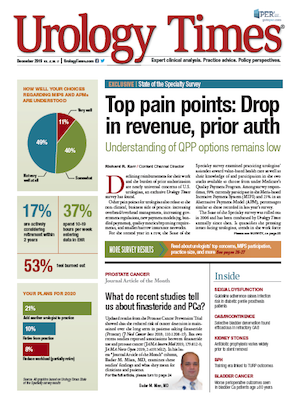Publication
Article
Urology Times Journal
Is clinician at fault for vesicovaginal fistula?
Author(s):
"Most people do not wish for their actions to be judged in hindsight; rather, if we are going to be judged, we want to be judged based on what we knew at the time," writes Acacia Brush Perko, Esq.
vchalup - stock.adobe.com


A 37-year-old file clerk experienced increased bleeding during menstrual periods and was referred to an OB/GYN by her internist. The OB/GYN concluded that the patient’s problem was due to a fibroid of the uterus, which at that early stage could be treated non-surgically. The patient continued to see the OB/GYN periodically for increased complaints of vaginal bleeding.
Two years later, the problem became severe and the patient’s only option, according to her OB/GYN, was to undergo a total abdominal hysterectomy. The patient signed a detailed informed consent form, which included potential complications of the surgery, including damage to the bladder. The patient was never offered a subtotal hysterectomy.
The surgery went forward without apparent complication. However, pink-tinged urine was seen in the Foley catheter, which was thought to be some bleeding in the bladder because the patient had been on medical anticoagulation.
For 7 consecutive days following the surgery, there were many entries in the hospital chart that the patient’s urine was “grossly bloody.” When the patient was discharged 9 days following surgery, her urine appeared to be clear.
Patient reports urine leakage
Two days after her discharge, the patient called her OB/GYN to complain that she had been leaking urine. She was seen by her OB/GYN the following day. It was thought that she was leaking urine due to a urinary tract infection.
Also by Acacia Brush Perko, Esq.: Lack of follow-up on x-ray leads to lawsuit
One month following discharge, she was examined by a urologist, who diagnosed a vesicovaginal fistula. The vesicovaginal fistula was treated conservatively with antibiotics and Foley catheter drainage for 2 months, when the patient was then referred to a gynecologic urologist. On consult with this specialist, the patient underwent reparative surgery followed by months of Foley catheter useage.
When the Foley catheter was finally removed, the patient began to leak urine again. She required a second reparative surgery, followed by Foley catheter urinary drainage for several months. When the catheter was removed, the urine stopped leaking.
The patient filed a malpractice lawsuit against the OB/GYN. The plaintiff alleged that the OB/GYN failed to fully advise the plaintiff of her surgical options, including undergoing a subtotal hysterectomy, which would have posed virtually no risk of inadvertent injury to the bladder and would have shortened the time of surgery.
The plaintiff also argued that a urologic consult would have determined that there was suture material in the bladder that could have been removed by a urologist using a cystoscope before a fistula developed. According to the plaintiff and her experts, it was below the standard of care for the OB/GYN to continue to believe that the blood in the urine was due to the anticoagulation therapy.
Next:"The OB/GYN and his experts argued that the standard of care did not require any discussion of the option of a subtotal hysterectomy unless the patient requested such information"In his defense, the OB/GYN contended that in light of the plaintiff’s significant uterine disease, which existed before his involvement with the patient’s care, performing an operation of less than a total hysterectomy would have been below the standard of care. The OB/GYN and his experts argued that the standard of care did not require any discussion of the option of a subtotal hysterectomy unless the patient requested such information.
The OB/GYN did not dispute the bladder injury during surgery, but maintained that such an injury is a known and accepted risk of a total hysterectomy and can occur in the absence of negligence. The OB/GYN and his experts also argued that it was reasonable to conclude that the blood in the urine was due to the “normal” trauma to the bladder incurred during such a surgery together with the plaintiff’s anticoagulation.
Read: Who’s to blame for man’s loss of kidney function?
Additionally, on the second postoperative day, the plaintiff’s Foley catheter was inadvertently pulled out, which the defense claimed was a traumatic event that caused bleeding in the bladder and urethra. Any bleeding after this “Foley event” was explained by that trauma plus the anticoagulation. Thus, the defense contended there was no need for a urologic consultation while the plaintiff was in the hospital.
The case proceeded to a jury trial, where the jury returned a 12-0 defense verdict, finding the OB/GYN met the standard of care.
LEGAL PERSPECTIVE: Whenever something does not go as planned, we have the habit of reviewing events in the rear-view mirror. The hindsight bias manifests in the tendency to exaggerate the extent to which a past event could have been predicted beforehand. It is easy to judge someone’s actions when the end result is known. Most people do not wish for their actions to be judged in hindsight; rather, if we are going to be judged, we want to be judged based on what we knew at the time. Thankfully, our civil justice system sees it that way too.
In a medical malpractice action, the standard of care, or the test of reasonableness, requires the jury to consider the defendant-doctor’s conduct in light of all the facts before him under the same or similar circumstances. In this case, it could have been easy to start with the vesicovaginal fistula and work backwards to criticize the OB/GYN. Yet that would be reviewing the defendant-doctor’s conduct in the rearview mirror. When reviewing the facts as presented to him, this jury correctly concluded that the OB/GYN’s actions were reasonable and within the standard of care.




























